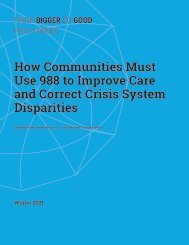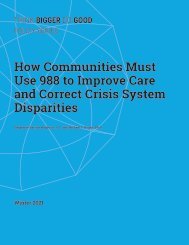Systemic, Racial Justice–Informed Solutions to Shift “Care” From the Criminal Legal System to the Mental Health Care System
Create successful ePaper yourself
Turn your PDF publications into a flip-book with our unique Google optimized e-Paper software.
THINK BIGGER DO GOOD<br />
POLICY SERIES<br />
<strong><strong>System</strong>ic</strong>, <strong>Racial</strong><br />
<strong>Justice–Informed</strong><br />
<strong>Solutions</strong> <strong>to</strong> <strong>Shift</strong><br />
<strong>“<strong>Care</strong>”</strong> <strong>From</strong> <strong>the</strong><br />
<strong>Criminal</strong> <strong>Legal</strong><br />
<strong>System</strong> <strong>to</strong> <strong>the</strong><br />
<strong>Mental</strong> <strong>Health</strong><br />
<strong>Care</strong> <strong>System</strong><br />
Sarah Y. Vinson, M.D., and Andrea L. Dennis, J.D.<br />
Spring 2021<br />
<strong><strong>System</strong>ic</strong>, <strong>Racial</strong> <strong>Justice–Informed</strong> <strong>Solutions</strong> <strong>to</strong> <strong>Shift</strong> <strong>“<strong>Care</strong>”</strong> <strong>From</strong> <strong>the</strong> <strong>Criminal</strong> <strong>Legal</strong> <strong>System</strong> <strong>to</strong> <strong>the</strong> <strong>Mental</strong> <strong>Health</strong> <strong>Care</strong> <strong>System</strong> 1
Behavioral <strong>Health</strong> and <strong>the</strong> Individual <strong>Health</strong> Insurance Market
Dear Reader,<br />
Now is <strong>the</strong> time <strong>to</strong> solve <strong>the</strong> growing behavioral health needs in our country by advancing public<br />
policies that transform <strong>the</strong> delivery of mental health and substance use disorder services and address<br />
outdated funding mechanisms.<br />
This paper is part of Think Bigger Do Good, a series of papers launched in 2017 through <strong>the</strong> support and<br />
leadership of <strong>the</strong> Thomas Scattergood Behavioral <strong>Health</strong> Foundation and Peg’s Foundation. While <strong>the</strong><br />
paper <strong>to</strong>pics continue <strong>to</strong> evolve, our goal <strong>to</strong> develop a policy agenda <strong>to</strong> improve health outcomes for all<br />
remains constant.<br />
In partnership with national experts in behavioral health, including our edi<strong>to</strong>rs, Howard Goldman<br />
and Constance Gartner, we identified seven critical <strong>to</strong>pics for this third series of papers. Each paper<br />
identifies <strong>the</strong> problem and provides clear, actionable solutions.<br />
We hope you join us in advocating for stronger behavioral health policies by sharing this paper with<br />
your programmatic partners, local, state, and federal decision makers, advocacy organizations, and<br />
voters. To learn more about Think Bigger Do Good and <strong>to</strong> access <strong>the</strong> o<strong>the</strong>r papers in <strong>the</strong> series, visit<br />
www.thinkbiggerdogood.org.<br />
Sincerely,<br />
Joseph Pyle, M.A.<br />
President<br />
Scattergood Foundation<br />
Founding Partner of Series<br />
Rick Kellar, M.B.A.<br />
President<br />
Peg’s Foundation<br />
Founding Partner of Series<br />
Jane Mogavero, Esq.<br />
Executive Direc<strong>to</strong>r<br />
Patrick P. Lee Foundation<br />
Tracy A. Sawicki<br />
Executive Direc<strong>to</strong>r<br />
Peter & Elizabeth Tower Foundation<br />
<strong><strong>System</strong>ic</strong>, <strong>Racial</strong> <strong>Justice–Informed</strong> <strong>Solutions</strong> <strong>to</strong> <strong>Shift</strong> <strong>“<strong>Care</strong>”</strong> <strong>From</strong> <strong>the</strong> <strong>Criminal</strong> <strong>Legal</strong> <strong>System</strong> <strong>to</strong> <strong>the</strong> <strong>Mental</strong> <strong>Health</strong> <strong>Care</strong> <strong>System</strong> 3
We would like <strong>to</strong> acknowledge <strong>the</strong> following individuals for <strong>the</strong>ir participation in<br />
<strong>the</strong> meeting that led <strong>to</strong> <strong>the</strong> conceptualization of <strong>the</strong> paper series.<br />
Colleen L. Barry, Ph.D., M.P.P.<br />
John Hopkins Bloomberg School of<br />
Public <strong>Health</strong><br />
Cynthia Baum-Baicker, Ph.D.<br />
The Scattergood Foundation<br />
Anita Burgos, Ph.D.<br />
Bipartisan Policy Center<br />
Thom Craig, M.P.A.<br />
Peg’s Foundation<br />
Rebecca David, M.P.H.<br />
National Council for Behavioral <strong>Health</strong><br />
Kelly Davis<br />
<strong>Mental</strong> <strong>Health</strong> America<br />
Lisa Dixon, M.D., M.P.H.<br />
Columbia University, NY State Psychiatric<br />
Institute, and Psychiatric Services<br />
Sara Dugan, Pharm.D., B.C.P.P., B.C.P.S.<br />
Nor<strong>the</strong>ast Ohio Medical University<br />
Peter Earley<br />
Author & Journalist<br />
Alyson Ferguson, M.P.H.<br />
The Scattergood Foundation<br />
Richard Frank, Ph.D.<br />
Harvard Medical School<br />
Rachel Garfield, Ph.D., M.H.S.<br />
The Henry J. Kaiser Family Foundation<br />
Mary Giliberti, J.D.<br />
<strong>Mental</strong> <strong>Health</strong> America<br />
Aaron Glickman, B.A.<br />
Perelman School of Medicine,<br />
University of Pennsylvania<br />
Sherry Glied, Ph.D.<br />
NYU Wagner School of Public Service<br />
Howard Goldman, M.D., Ph.D.<br />
University of Maryland School<br />
of Medicine<br />
Pamela Greenberg, M.P.P.<br />
Association for Behavioral <strong>Health</strong><br />
and Wellness<br />
Kimberly Hoagwood, Ph.D.<br />
New York University School of Medicine<br />
Michael F. Hogan, Ph.D.<br />
Hogan <strong>Health</strong> <strong>Solutions</strong><br />
Chuck Ingoglia, M.S.W.<br />
National Council for Behavioral <strong>Health</strong><br />
Rick Kellar, M.B.A.<br />
Peg’s Foundation<br />
Kelly Kelleher, M.D., M.P.H.<br />
The Research Institute at Nationwide<br />
Children’s Hospital<br />
Jennifer Mathis, J.D.<br />
Bazelon Center for <strong>Mental</strong> <strong>Health</strong> Law<br />
Donald Matteson, M.A.<br />
Peter & Elizabeth Tower Foundation<br />
Brian McGregor, Ph.D.<br />
Satcher <strong>Health</strong> Leadership Institute,<br />
Morehouse College<br />
Erik Messamore, M.D.<br />
Nor<strong>the</strong>ast Ohio Medical University<br />
Ben Miller, PsyD<br />
Well Being Trust<br />
Jane Mogavero, Esq.<br />
Patrick P. Lee Foundation<br />
Mark R. Munetz, M.D.<br />
Nor<strong>the</strong>ast Ohio Medical University<br />
Sandra Newman, Ph.D.<br />
John Hopkins Bloomberg School of<br />
Public <strong>Health</strong><br />
Joseph Pyle, M.A.<br />
The Scattergood Foundation<br />
Barbara Ricci<br />
Center for High Impact Philanthropy<br />
Cheryl Roberts, Esq.<br />
Greenberger Center<br />
Vic<strong>to</strong>ria Romanda<br />
Peg’s Foundation<br />
Tracy A. Sawicki<br />
Peter & Elizabeth Tower Foundation<br />
Lloyd Sederer, M.D.<br />
NYS Office of <strong>Mental</strong> <strong>Health</strong>/Mailman<br />
School of Public <strong>Health</strong><br />
Dominic Sisti, Ph.D.<br />
Scattergood Program for Applied Ethics<br />
in Behavioral <strong>Health</strong> <strong>Care</strong> & Perelman<br />
School of Medicine at <strong>the</strong> University<br />
of Pennsylvania<br />
Andrew Sperling, J.D.<br />
NAMI<br />
Kate Williams, J.D.<br />
The Scattergood Foundation<br />
Glenda L. Wrenn, M.D., M.S.H.P.<br />
180 <strong>Health</strong> Partners<br />
<strong><strong>System</strong>ic</strong>, <strong>Racial</strong> <strong>Justice–Informed</strong> <strong>Solutions</strong> <strong>to</strong> <strong>Shift</strong> <strong>“<strong>Care</strong>”</strong> <strong>From</strong> <strong>the</strong> <strong>Criminal</strong> <strong>Legal</strong> <strong>System</strong> <strong>to</strong> <strong>the</strong> <strong>Mental</strong> <strong>Health</strong> <strong>Care</strong> <strong>System</strong> 4
Titles in <strong>the</strong> Paper Series<br />
Edi<strong>to</strong>rs Howard Goldman, M.D., Ph.D., and Constance Gartner, M.S.W.<br />
America’s Opioid Epidemic<br />
Lloyd I. Sederer, M.D.<br />
Behavioral <strong>Health</strong> and <strong>the</strong> Individual <strong>Health</strong> Insurance Market: Preserving Key Elements of Reform<br />
Richard G. Frank, Ph.D., and Sherry A. Glied, Ph.D., M.A.<br />
Bringing Treatment Parity <strong>to</strong> Jail Inmates with Schizophrenia<br />
Mark R. Munetz, M.D., Erik Messamore, M.D., Ph.D., and Sara E. Dugan, Pharm.D., B.C.P.P., B.C.P.S.<br />
Coordinated Specialty <strong>Care</strong> for First-Episode Psychosis: An Example of Financing for Specialty Programs<br />
Lisa B. Dixon, M.D., M.P.H.<br />
COVID-19, Structural Racism, and <strong>Mental</strong> <strong>Health</strong> Inequities: Policy Implications for an Emerging Syndemic<br />
Ruth S. Shim, M.D., M.P.H., and Steven M. Starks, M.D.<br />
Employing People with <strong>Mental</strong> Illness in <strong>the</strong> 21st Century: Labor Market Changes and Policy Challenges<br />
Richard G. Frank, Ph.D., and Sherry A. Glied, Ph.D., M.A.<br />
Fentanyl and <strong>the</strong> Evolving Opioid Epidemic: What Strategies Should Policymakers Consider?<br />
Colleen L. Barry, Ph.D., M.P.P.<br />
Housing Is <strong>Mental</strong> <strong>Health</strong> <strong>Care</strong>: A Call for Medicaid Demonstration Waivers Covering Housing<br />
Jennifer Mathis, J.D.<br />
Improving Outcomes for People with Serious <strong>Mental</strong> Illness and Co-Occurring Substance Use<br />
Disorders in Contact with <strong>the</strong> <strong>Criminal</strong> Justice <strong>System</strong><br />
Glenda L. Wrenn, M.D., M.S.H.P., Brian McGregor, Ph.D., and Mark R. Munetz, M.D.<br />
Informed Consent: A Policy Prescription for Communicating Benefit and Risk in State Medical Marijuana Program<br />
Erik Messamore, M.D., Ph.D., and Sara E. Dugan, Pharm.D., B.C.P.P., B.C.P.S.<br />
Integrating <strong>Mental</strong> <strong>Health</strong> and Addiction Treatment in General Medical <strong>Care</strong>: The Role of Policy<br />
Emma B. McGinty, Ph.D., M.S., and Gail L. Daumit, M.D., M.H.S.<br />
Medicaid’s Institutions for <strong>Mental</strong> Diseases (IMD) Exclusion Rule: A Policy Debate<br />
Jennifer Mathis, J.D., Dominic A. Sisti, Ph.D., and Aaron Glickman, B.A.<br />
Meeting <strong>the</strong> Needs of Justice-Involved People with Serious <strong>Mental</strong> Illness within Community<br />
Behavioral <strong>Health</strong> <strong>System</strong>s<br />
Natalie Bonfine, Ph.D., Amy Blank Wilson, Ph.D., L.S.W., and Mark R. Munetz, M.D.<br />
New Opportunities <strong>to</strong> Improve <strong>Mental</strong> <strong>Health</strong> Crisis <strong>System</strong>s<br />
Michael F. Hogan, Ph.D., and Ma<strong>the</strong>w L. Goldman, M.D., M.S.<br />
<strong><strong>System</strong>ic</strong>, <strong>Racial</strong> <strong>Justice–Informed</strong> <strong>Solutions</strong> <strong>to</strong> <strong>Shift</strong> <strong>“<strong>Care</strong>”</strong> <strong>From</strong> <strong>the</strong> <strong>Criminal</strong> <strong>Legal</strong> <strong>System</strong> <strong>to</strong> <strong>the</strong> <strong>Mental</strong> <strong>Health</strong> <strong>Care</strong> <strong>System</strong> 5
Redesigning Federal <strong>Health</strong> Insurance Policies <strong>to</strong> Promote Children’s <strong>Mental</strong> <strong>Health</strong><br />
Kimberly Hoagwood, Ph.D., Kelly Kelleher, M.D., M.P.H., and Michael F. Hogan, Ph.D.<br />
Policy and Practice Innovations <strong>to</strong> Improve Prescribing of Psychoactive Medications for Children<br />
Kelly J. Kelleher, M.D., M.P.H., David Rubin, M.D., M.S.C.E., and Kimberly Hoagwood, Ph.D.<br />
Preventing Suicide Through Better Firearm Safety Policy in <strong>the</strong> United States<br />
Jeffrey W. Swanson, Ph.D.<br />
Suicide Is a Significant <strong>Health</strong> Problem<br />
Michael F. Hogan, Ph.D.<br />
The Current Medicaid Policy Debate and Implications for Behavioral <strong>Health</strong>care in <strong>the</strong> United States<br />
Rachel Garfield, Ph.D., M.H.S., and Julia Zur, Ph.D.<br />
Youth Suicide Is Increasing: Modest Actions Taken Now Can Save Lives<br />
Michael F. Hogan, Ph.D.<br />
Find <strong>the</strong> papers online at www.thinkbiggerdogood.org<br />
We are grateful for <strong>the</strong> partnership that allows this paper and o<strong>the</strong>rs <strong>to</strong> appear<br />
in Psychiatric Services, a peer-reviewed monthly journal of <strong>the</strong> American Psychiatric<br />
Association. Content can be viewed at ps.psychiatryonline.org.<br />
<strong><strong>System</strong>ic</strong>, <strong>Racial</strong> <strong>Justice–Informed</strong> <strong>Solutions</strong> <strong>to</strong> <strong>Shift</strong> <strong>“<strong>Care</strong>”</strong> <strong>From</strong> <strong>the</strong> <strong>Criminal</strong> <strong>Legal</strong> <strong>System</strong> <strong>to</strong> <strong>the</strong> <strong>Mental</strong> <strong>Health</strong> <strong>Care</strong> <strong>System</strong> 6
<strong><strong>System</strong>ic</strong>, <strong>Racial</strong><br />
<strong>Justice–Informed</strong><br />
<strong>Solutions</strong> <strong>to</strong> <strong>Shift</strong><br />
<strong>“<strong>Care</strong>”</strong> <strong>From</strong> <strong>the</strong><br />
<strong>Criminal</strong> <strong>Legal</strong> <strong>System</strong><br />
<strong>to</strong> <strong>the</strong> <strong>Mental</strong> <strong>Health</strong><br />
<strong>Care</strong> <strong>System</strong><br />
Sarah Y. Vinson, M.D.<br />
Associate Professor of Psychiatry and Pediatrics<br />
Department of Psychiatry and Behavioral Sciences<br />
Morehouse School of Medicine<br />
Principal Consultant<br />
Lorio Forensics<br />
svinson@msm.edu<br />
Andrea L. Dennis, J.D.<br />
Associate Dean for Faculty Development<br />
John Byrd Martin Chair of Law<br />
University of Georgia School of Law<br />
aldennis@uga.edu<br />
<strong><strong>System</strong>ic</strong>, <strong>Racial</strong> <strong>Justice–Informed</strong> <strong>Solutions</strong> <strong>to</strong> <strong>Shift</strong> <strong>“<strong>Care</strong>”</strong> <strong>From</strong> <strong>the</strong> <strong>Criminal</strong> <strong>Legal</strong> <strong>System</strong> <strong>to</strong> <strong>the</strong> <strong>Mental</strong> <strong>Health</strong> <strong>Care</strong> <strong>System</strong> 7
1<br />
Introduction<br />
The current configuration and function of <strong>the</strong> U.S. societal structures drives <strong>the</strong><br />
overrepresentation of people with serious mental illness in <strong>the</strong> criminal legal<br />
system. Although <strong>the</strong> causes are multifac<strong>to</strong>rial, <strong>the</strong> mental health system poorly<br />
serves those at highest risk of criminal legal system involvement. Asserting that<br />
<strong>the</strong> central problem is <strong>the</strong> division of labor between <strong>the</strong> mental health system and<br />
<strong>the</strong> criminal justice system, Bonfine et al. (1) articulated <strong>the</strong> need for an “integrated<br />
community health system—i.e., “intercept 0” for <strong>the</strong> coordination and integration<br />
of services for this population. Intercept 0 is <strong>the</strong> first step in <strong>the</strong> sequential<br />
intercept model, which describes “how individuals with mental and substance use<br />
disorders come in<strong>to</strong> contact with and move through <strong>the</strong> criminal justice system”<br />
and “helps communities identify resources and gaps in services at each intercept<br />
and develop local strategic action plans” (2). At intercept 0, individuals in crisis<br />
are diverted in<strong>to</strong> local crisis care services without requiring a call <strong>to</strong> 911. They are<br />
paired with treatment or services instead of arrested or charged with a crime (2).<br />
Responsibility for addressing <strong>the</strong> needs of those with severe mental illness should<br />
rest with <strong>the</strong> mental health system ra<strong>the</strong>r than with <strong>the</strong> criminal legal system.<br />
However, <strong>the</strong> current division of labor between <strong>the</strong> two systems is just part of <strong>the</strong><br />
problem. Simply put, <strong>the</strong> mental health system is not consistently accessible <strong>to</strong> or<br />
effective for those at highest risk of criminal legal system involvement.<br />
Responsibility for addressing <strong>the</strong> needs of those<br />
with severe mental illness should rest with <strong>the</strong><br />
mental health system ra<strong>the</strong>r than with <strong>the</strong> criminal<br />
legal system.<br />
<strong><strong>System</strong>ic</strong>, <strong>Racial</strong> <strong>Justice–Informed</strong> <strong>Solutions</strong> <strong>to</strong> <strong>Shift</strong> <strong>“<strong>Care</strong>”</strong> <strong>From</strong> <strong>the</strong> <strong>Criminal</strong> <strong>Legal</strong> <strong>System</strong> <strong>to</strong> <strong>the</strong> <strong>Mental</strong> <strong>Health</strong> <strong>Care</strong> <strong>System</strong> 8
The roots of mental health care inequities are myriad,<br />
intersecting with <strong>the</strong> roots of o<strong>the</strong>r inequitable systems<br />
that shape critical social determinants of mental<br />
health. Fur<strong>the</strong>r, many in <strong>the</strong> populations most at risk of<br />
overrepresentation in <strong>the</strong> criminal legal system are not<br />
served by <strong>the</strong> mental health care system at all, because<br />
<strong>the</strong> health insurance safety net in <strong>the</strong> form of Medicaid<br />
does not reach all adults in need of coverage. This gap<br />
is particularly relevant in states that opted against<br />
expansion under <strong>the</strong> Affordable <strong>Care</strong> Act. Notably, as of<br />
summer 2020, six of <strong>the</strong> ten states with <strong>the</strong> highest per<br />
capita incarceration rates had not implemented Medicaid<br />
expansion (3, 4), even with <strong>the</strong> current federal incentives.<br />
The growth of <strong>the</strong> evidence base regarding <strong>the</strong> social<br />
determinants of mental health has ushered in greater<br />
understanding of <strong>the</strong>ir central role in <strong>the</strong> promotion and<br />
maintenance of mental illness and health. These academic<br />
strides, however, have failed <strong>to</strong> translate in<strong>to</strong> widespread<br />
care and payment policy changes. Additionally, as is <strong>the</strong><br />
case with <strong>the</strong> criminal legal system, structural racism<br />
(i.e., “<strong>the</strong> <strong>to</strong>tality of ways in which societies foster [racial]<br />
discrimination, via mutually reinforcing [inequitable]<br />
systems . . . that in turn reinforce discrimina<strong>to</strong>ry beliefs,<br />
values, and distribution of resources” [5]) shapes people’s<br />
experiences in <strong>the</strong> mental health care system, contributing<br />
<strong>to</strong> inequitable mental health outcomes for individuals<br />
from racial-ethnic minority groups with severe mental<br />
illness (6). Since Black and Brown people make up<br />
more than half of those incarcerated in <strong>the</strong> United<br />
States (despite being just 32% of <strong>the</strong> <strong>to</strong>tal population) (7),<br />
structural racism is a critical fac<strong>to</strong>r in preparing for <strong>the</strong><br />
shift of care <strong>to</strong> <strong>the</strong> mental health system from <strong>the</strong> criminal<br />
legal system. Reform must not only promote, fund, and<br />
coordinate more person-centered, wholistic care, it must<br />
also account for, and take corrective action against, <strong>the</strong><br />
reality of racism in <strong>the</strong> mental health care system.<br />
Given <strong>the</strong> demographics of populations that are<br />
disproportionately incarcerated, any examination of<br />
criminal legal system overrepresentation must consider<br />
<strong>the</strong> population’s tremendous intersectionality with<br />
racial-ethnic minority and o<strong>the</strong>r marginalized groups,<br />
including those who are impoverished, poorly educated,<br />
and un- or underemployed (8). In <strong>the</strong> conceptualization<br />
of criminogenic risk fac<strong>to</strong>rs, a structural lens, although<br />
highly relevant, is inconsistently applied. These risk<br />
fac<strong>to</strong>rs, including many of those characterized as<br />
individualistic, are in fact influenced by inequitable<br />
societal structures, such as <strong>the</strong> housing, educational,<br />
and employment systems.<br />
In <strong>the</strong> absence of an intersectional, antiracist, structurally<br />
informed approach, any attempt by <strong>the</strong> mental health<br />
care system <strong>to</strong> stem <strong>the</strong> overrepresentation of people<br />
with serious mental illness in <strong>the</strong> criminal legal system<br />
will fail. Medicaid policy plays a prominent role in this<br />
issue, given its influence in <strong>the</strong> care of those living<br />
with serious mental illness and those living in poverty.<br />
Although making changes in Medicaid can improve<br />
<strong>the</strong> mental health care system’s ability <strong>to</strong> serve this<br />
population, multisystemic reforms would be required for<br />
truly equitable outcomes. This reality does not absolve<br />
<strong>the</strong> Medicaid and mental health care systems from<br />
doing <strong>the</strong>ir part. This article will provide an overview of<br />
<strong>the</strong> current mental health care system’s shortcomings<br />
in serving this population. It will <strong>the</strong>n propose concrete<br />
steps that can be taken <strong>to</strong> address <strong>the</strong>se shortcomings<br />
with a special focus on race and social determinants<br />
of health.<br />
.<br />
<strong><strong>System</strong>ic</strong>, <strong>Racial</strong> <strong>Justice–Informed</strong> <strong>Solutions</strong> <strong>to</strong> <strong>Shift</strong> <strong>“<strong>Care</strong>”</strong> <strong>From</strong> <strong>the</strong> <strong>Criminal</strong> <strong>Legal</strong> <strong>System</strong> <strong>to</strong> <strong>the</strong> <strong>Mental</strong> <strong>Health</strong> <strong>Care</strong> <strong>System</strong> 9
2<br />
<strong>Mental</strong> <strong>Health</strong> <strong>System</strong><br />
Practice and Policy<br />
Shortcomings for<br />
Serving as Intercept 0<br />
In sum, a mental health care system serving as intercept 0 would catch<br />
individuals with severe mental illness before <strong>the</strong>y are ensnared in <strong>the</strong> criminal<br />
legal system. The premise is that an integrated, coordinated, community-based<br />
system would address illness, shape behaviors, and decrease <strong>the</strong> risk of those<br />
with severe mental illness coming in<strong>to</strong> contact with <strong>the</strong> criminal legal system—<br />
contact that places <strong>the</strong> criminal legal system in <strong>the</strong> position of dictating mental<br />
health care service provision and parameters for those in its cus<strong>to</strong>dy or under its<br />
supervision (1). Currently, <strong>the</strong> mental health system is ill equipped <strong>to</strong> function in<br />
this role.<br />
In sum, a mental health care system serving as<br />
intercept 0 would catch individuals with severe<br />
mental illness before <strong>the</strong>y are ensnared in <strong>the</strong><br />
criminal legal system.<br />
<strong><strong>System</strong>ic</strong>, <strong>Racial</strong> <strong>Justice–Informed</strong> <strong>Solutions</strong> <strong>to</strong> <strong>Shift</strong> <strong>“<strong>Care</strong>”</strong> <strong>From</strong> <strong>the</strong> <strong>Criminal</strong> <strong>Legal</strong> <strong>System</strong> <strong>to</strong> <strong>the</strong> <strong>Mental</strong> <strong>Health</strong> <strong>Care</strong> <strong>System</strong> 10
Many individuals with severe mental illness<br />
could perform a low-skilled job; however, <strong>the</strong>se<br />
positions often do not have employer-based<br />
health coverage.<br />
Medicaid Access Inequities<br />
In nearly all states that have not implemented Medicaid expansion, childless<br />
adults are not able <strong>to</strong> qualify for Medicaid on <strong>the</strong> basis of low income (9). Although<br />
Supplemental Security Income (SSI) benefits may provide a path <strong>to</strong> Medicaid<br />
coverage in states that did not expand Medicaid under <strong>the</strong> Affordable <strong>Care</strong> Act, <strong>the</strong><br />
complexity of <strong>the</strong> application process can prove challenging <strong>to</strong> people impaired<br />
by disabling symp<strong>to</strong>ms of mental illness. Thus not all who would qualify for <strong>the</strong>se<br />
benefits successfully apply for and receive <strong>the</strong>m. Additionally, criminal legal<br />
system involvement, incarceration in particular, results in Medicaid suspension,<br />
and in 19 states, it results in termination (10). Fur<strong>the</strong>rmore, many people may not<br />
be disabled enough for disability benefits but are not skilled enough <strong>to</strong> access a<br />
job with employer health care benefits. Under <strong>the</strong> disability definition used for SSI<br />
eligibility, <strong>the</strong> person must be unable <strong>to</strong> perform “substantial gainful activity” or<br />
must not have earnings averaging over $1,260 per month (11). Many individuals<br />
with severe mental illness could perform a low-skilled job; however, <strong>the</strong>se<br />
positions often do not have employer-based health coverage. In states that do<br />
offer Medicaid based on income, <strong>the</strong>se same jobs can raise <strong>the</strong> workers’ income <strong>to</strong><br />
a level beyond <strong>the</strong> Medicaid income threshold.<br />
<strong><strong>System</strong>ic</strong>, <strong>Racial</strong> <strong>Justice–Informed</strong> <strong>Solutions</strong> <strong>to</strong> <strong>Shift</strong> <strong>“<strong>Care</strong>”</strong> <strong>From</strong> <strong>the</strong> <strong>Criminal</strong> <strong>Legal</strong> <strong>System</strong> <strong>to</strong> <strong>the</strong> <strong>Mental</strong> <strong>Health</strong> <strong>Care</strong> <strong>System</strong> 11
Disparities Between Covered Services and Needed Resources<br />
For those fortunate enough <strong>to</strong> obtain Medicaid, <strong>the</strong>re is frequently a lack of<br />
alignment between covered services and needed resources. Conceptualizations<br />
of illness and approaches <strong>to</strong> treatment that overemphasize an individual’s<br />
psychiatric symp<strong>to</strong>ms and traditional medical remedies fall short of appreciating<br />
and addressing <strong>the</strong> social determinants of mental health (12). Despite evidence<br />
that addressing <strong>the</strong>se issues is beneficial <strong>to</strong> mental health outcomes (13),<br />
Medicaid reimbursement is inconsistently available for case management and<br />
interventions, such as supported employment and supportive housing, with<br />
direct impact on well-characterized social determinants, such as housing and<br />
vocational opportunities. Admittedly, sweeping improvements in <strong>the</strong>se social<br />
determinants will require policy changes that go beyond <strong>the</strong> remit of Medicaid<br />
and <strong>the</strong> mental health system.<br />
Admittedly, sweeping improvements in <strong>the</strong>se<br />
social determinants will require policy changes<br />
that go beyond <strong>the</strong> remit of Medicaid and <strong>the</strong><br />
mental health system.<br />
Even when it comes <strong>to</strong> narrowly defined, traditional medical interventions for<br />
mental illness, Medicaid coverage does not necessarily guarantee access. Service<br />
network inadequacies—i.e., <strong>to</strong>o few providers and facilities that participate in<br />
Medicaid networks—can preclude <strong>the</strong> actual provision of care. <strong>Mental</strong> health<br />
provider shortages are more likely <strong>to</strong> exist in lower-income communities (14).<br />
Medicaid would be of particular importance <strong>to</strong> this population that contends<br />
with a larger burden of adverse social determinants of mental health (such<br />
as segregationist housing policies) and where <strong>the</strong> population experiences <strong>the</strong><br />
greatest impacts of mass incarceration. Additionally, office-based mental health<br />
care providers often opt out of providing care <strong>to</strong> publicly insured patients (and in<br />
many cases even <strong>to</strong> privately insured patients) (15). Low Medicaid reimbursement<br />
relative <strong>to</strong> Medicare and private insurance reimbursement plays a role (16), but<br />
one must also consider <strong>the</strong> make-up of <strong>the</strong> mental health workforce (e.g., those<br />
with graduate or professional school education, such as master’s and doc<strong>to</strong>rallevel<br />
clinical degrees).<br />
<strong><strong>System</strong>ic</strong>, <strong>Racial</strong> <strong>Justice–Informed</strong> <strong>Solutions</strong> <strong>to</strong> <strong>Shift</strong> <strong>“<strong>Care</strong>”</strong> <strong>From</strong> <strong>the</strong> <strong>Criminal</strong> <strong>Legal</strong> <strong>System</strong> <strong>to</strong> <strong>the</strong> <strong>Mental</strong> <strong>Health</strong> <strong>Care</strong> <strong>System</strong> 12
Representation and Racism in <strong>Mental</strong> <strong>Health</strong> <strong>Care</strong><br />
Physicians have been shown <strong>to</strong> be less likely <strong>to</strong> accept<br />
Medicaid in areas where <strong>the</strong> poor are non-White (17).<br />
Providers from racial and ethnic minority groups, when<br />
provided <strong>the</strong> opportunity <strong>to</strong> gain medical and mental<br />
health professional expertise, treat a higher proportion<br />
of minority and underserved patients than do White<br />
providers (18). Yet mental health workforce diversity<br />
is lacking—with <strong>the</strong> starkest underrepresentation<br />
being that of Black and Latinx providers (19). Notably,<br />
<strong>the</strong>se populations are <strong>the</strong> same ones that are grossly<br />
overrepresented in <strong>the</strong> criminal legal system, with<br />
a Latinx-White state imprisonment disparity of 1.6<br />
<strong>to</strong> 1.0, and a Black–White disparity of 5.1 <strong>to</strong> 1.0 (20).<br />
Consequently, <strong>the</strong> lived experiences of professionals<br />
providing mental health care, choosing whom <strong>to</strong> care<br />
for, and making mental health procedural and policy<br />
decisions (largely middle- and upper-class White people)<br />
are significantly disparate from <strong>the</strong> lived experiences of<br />
those with mental illness who are overrepresented in <strong>the</strong><br />
criminal legal system. This has implications not only for<br />
where care is provided, but how.<br />
At every stage of mental health care<br />
system involvement, <strong>the</strong> racial and<br />
ethnic groups overrepresented in<br />
<strong>the</strong> criminal legal system, Black and<br />
Latinx people, have poorer outcomes,<br />
compared with Whites.<br />
As defined by Ibram X. Kendi (21), racism is “a marriage<br />
of racist policies and racist ideas that produces and<br />
normalizes racial inequities.” The racially inequitable<br />
products of <strong>the</strong> mental health care system are well<br />
documented and have been for decades (18). At every<br />
stage of mental health care system involvement—i.e.,<br />
access, engagement, assessment, treatment choice, and<br />
retention—<strong>the</strong> racial and ethnic groups overrepresented<br />
in <strong>the</strong> criminal legal system, Black and Latinx people<br />
(20), have poorer outcomes, compared with Whites. When<br />
systems purport <strong>to</strong> be taking steps <strong>to</strong> address <strong>the</strong>se<br />
problems, <strong>the</strong> approaches are often superficial and focused<br />
on <strong>the</strong> underserved populations (i.e., cultural competency<br />
trainings focused on cultural differences, mistrust, and<br />
stigma), ra<strong>the</strong>r than on <strong>the</strong> underserving system.<br />
<strong><strong>System</strong>ic</strong>, <strong>Racial</strong> <strong>Justice–Informed</strong> <strong>Solutions</strong> <strong>to</strong> <strong>Shift</strong> <strong>“<strong>Care</strong>”</strong> <strong>From</strong> <strong>the</strong> <strong>Criminal</strong> <strong>Legal</strong> <strong>System</strong> <strong>to</strong> <strong>the</strong> <strong>Mental</strong> <strong>Health</strong> <strong>Care</strong> <strong>System</strong> 13
Accounting for structural racism should be a key<br />
consideration in any health reform effort, but it is<br />
absolutely essential for a population with racial- and<br />
ethnic-minority overrepresentation. Stark inequities<br />
permeate every stage of <strong>the</strong> criminal legal process (i.e.,<br />
law enforcement officer contact, investigation, arrest,<br />
detention, charging, adjudication, and sentencing). In<br />
<strong>the</strong> absence of antiracist incentives from payers, mental<br />
health care providers and systems often fail even <strong>to</strong><br />
identify, let alone address, <strong>the</strong> role of <strong>the</strong>ir ideas and<br />
policies in <strong>the</strong> creation and maintenance of inequities.<br />
Thus structural racism is perpetuated through <strong>the</strong> mental<br />
health care system.<br />
Accounting for structural racism<br />
should be a key consideration in<br />
any health reform effort, but it is<br />
absolutely essential for a population<br />
with racial- and ethnic-minority<br />
overrepresentation.<br />
Evidence-Based Treatment Access<br />
Even when treatment is accessible, evidence-based<br />
treatment may not be. A study by Bruns et al. (22)<br />
using data from state mental health authority (SMHA)<br />
administra<strong>to</strong>rs found significant interstate variability<br />
in rates of evidence-based treatment (EBT) funding,<br />
supportive policies, and adoption. In states that had<br />
implemented EBTs, penetration of <strong>the</strong>se services was<br />
poor. In o<strong>the</strong>r words, most of those who needed evidencebased<br />
services did not receive <strong>the</strong>m. The results of a<br />
follow-up study suggested that states’ funding of EBT<br />
and associated infrastructures was predicted by state<br />
per capita income, expansion of Medicaid under <strong>the</strong><br />
Affordable <strong>Care</strong> Act, Democratic political control, <strong>the</strong><br />
presence of state behavioral health research entities,<br />
and <strong>the</strong> degree of interagency collaboration; states’<br />
EBT supportive policies were predicted by interagency<br />
collaboration and <strong>the</strong> presence of SMHA research entities;<br />
and EBT adoption was predicted by <strong>the</strong> SMHA directly<br />
operating community-based programs (as opposed <strong>to</strong><br />
merely funding services) (23).<br />
<strong><strong>System</strong>ic</strong>, <strong>Racial</strong> <strong>Justice–Informed</strong> <strong>Solutions</strong> <strong>to</strong> <strong>Shift</strong> <strong>“<strong>Care</strong>”</strong> <strong>From</strong> <strong>the</strong> <strong>Criminal</strong> <strong>Legal</strong> <strong>System</strong> <strong>to</strong> <strong>the</strong> <strong>Mental</strong> <strong>Health</strong> <strong>Care</strong> <strong>System</strong> 14
3<br />
Reforming <strong>Health</strong><br />
<strong>Care</strong> <strong>to</strong> Serve as<br />
Intercept 0<br />
Efforts <strong>to</strong> reduce recidivism and improve mental health outcomes often<br />
focus on “fixing” <strong>the</strong> so-called “noncompliant” or “difficult” patients and <strong>the</strong>ir<br />
criminogenic risk fac<strong>to</strong>rs. Effective solutions may be found instead by questioning<br />
systemic deficiencies and barriers <strong>to</strong> better serving this population: How do we<br />
change <strong>the</strong> system <strong>to</strong> improve mental health outcomes, particularly for those<br />
with serious mental illness and criminal legal system involvement? Initially,<br />
reforms should target four core areas: expanding access <strong>to</strong> coverage through<br />
Medicaid reforms, increasing service provision through health care workforce<br />
diversification, enhancing <strong>the</strong> effectiveness of Medicaid through incentivizing<br />
antiracist practices, and providing more support for wraparound and evidencebased<br />
services.<br />
How do we change <strong>the</strong> system <strong>to</strong> improve mental<br />
health outcomes, particularly for those with<br />
serious mental illness and criminal legal system<br />
involvement?<br />
<strong><strong>System</strong>ic</strong>, <strong>Racial</strong> <strong>Justice–Informed</strong> <strong>Solutions</strong> <strong>to</strong> <strong>Shift</strong> <strong>“<strong>Care</strong>”</strong> <strong>From</strong> <strong>the</strong> <strong>Criminal</strong> <strong>Legal</strong> <strong>System</strong> <strong>to</strong> <strong>the</strong> <strong>Mental</strong> <strong>Health</strong> <strong>Care</strong> <strong>System</strong> 15
Medicaid Coverage and Access<br />
Reform must expand access <strong>to</strong> and consistency of<br />
Medicaid coverage for all who need it but especially<br />
for those with serious mental illness who are ei<strong>the</strong>r<br />
at high risk of or who already have criminal legal<br />
system involvement. These individuals’ coverage needs<br />
protection from fluctuations in incarceration, SSI, or<br />
employment status. In every state, every adult, including<br />
<strong>the</strong> working poor who do not have SSI, should be given<br />
access <strong>to</strong> Medicaid. This change would also remove a<br />
potential disincentive (losing Medicaid eligibility) <strong>to</strong><br />
working, an activity that promotes successful community<br />
reentry and mental health recovery. In order <strong>to</strong> cover <strong>the</strong><br />
working poor and <strong>to</strong> support recovery-oriented care for<br />
those with serious mental illness, <strong>the</strong> Medicaid income<br />
eligibility for working individuals should be raised <strong>to</strong> 250%<br />
of <strong>the</strong> federal poverty level. In fur<strong>the</strong>rance of successful<br />
reentry programming, incarcerated individuals’ Medicaid<br />
benefits should be suspended on a time-limited basis and<br />
not terminated. Efforts should also be made <strong>to</strong> identify<br />
and begin <strong>the</strong> enrollment process for eligible individuals<br />
before release. Notably, of <strong>the</strong> 12 states that have not<br />
expanded Medicaid access, two are in <strong>the</strong> <strong>to</strong>p five for<br />
incarceration rates (Mississippi and Texas), and three are<br />
in <strong>the</strong> <strong>to</strong>p five for numbers of incarcerated individuals<br />
(Texas, Florida, and Georgia) (3, 4). Given <strong>the</strong> sheer<br />
number of current and formerly incarcerated people in<br />
<strong>the</strong>se states, Medicaid expansion in all states is critical<br />
for those with serious mental illness and criminal legal<br />
system involvement. For states that have not expanded<br />
Medicaid <strong>to</strong> do so and for those that have <strong>to</strong> fur<strong>the</strong>r<br />
increase <strong>the</strong>ir Medicaid rolls, a significant investment at<br />
both <strong>the</strong> state and <strong>the</strong> federal levels is necessary. State<br />
participation could be incentivized by an increase in <strong>the</strong><br />
federal match for newly covered individuals back <strong>to</strong> 100%<br />
and a federal commitment <strong>to</strong> permanent matching.<br />
Without more mental health clinicians willing <strong>to</strong><br />
provide care <strong>to</strong> patients with Medicaid, <strong>the</strong> impact of<br />
expansion on access will be limited. As noted above,<br />
low Medicaid reimbursement is a contribu<strong>to</strong>r <strong>to</strong> low<br />
provider participation. States control Medicaid spending<br />
by setting provider reimbursement rates lower than<br />
Medicare and private market rates, which in turn deters<br />
providers from joining Medicaid services and practicing<br />
in <strong>the</strong> communities most affected by criminal legal<br />
system involvement. This is especially true for outpatient<br />
services (24), a key component in both early intervention<br />
and continuity of care for individuals with serious mental<br />
illness and in successful community reintegration.<br />
Medicaid reimbursement increases<br />
can incentivize both systems and<br />
providers <strong>to</strong> serve <strong>the</strong>se highly<br />
vulnerable individuals.<br />
Medicaid reimbursement increases can incentivize both<br />
systems and providers <strong>to</strong> serve <strong>the</strong>se highly vulnerable<br />
individuals. At current rates, reimbursement sometimes<br />
does not even cover <strong>the</strong> costs of service provision. It<br />
is recommended that states be required <strong>to</strong> reimburse<br />
providers at <strong>the</strong> same rate that Medicare does for<br />
comparable services or, at <strong>the</strong> very least, for <strong>the</strong> federal<br />
government <strong>to</strong> offer earmarked grants for states so that<br />
<strong>the</strong>y can raise reimbursement <strong>to</strong> a uniform percentage of<br />
Medicare rates.<br />
<strong><strong>System</strong>ic</strong>, <strong>Racial</strong> <strong>Justice–Informed</strong> <strong>Solutions</strong> <strong>to</strong> <strong>Shift</strong> <strong>“<strong>Care</strong>”</strong> <strong>From</strong> <strong>the</strong> <strong>Criminal</strong> <strong>Legal</strong> <strong>System</strong> <strong>to</strong> <strong>the</strong> <strong>Mental</strong> <strong>Health</strong> <strong>Care</strong> <strong>System</strong> 16
Expansion and Diversification of <strong>the</strong> <strong>Mental</strong><br />
<strong>Health</strong> Workforce<br />
Not only is an expanded mental health workforce needed,<br />
but effective reform that serves those disproportionately<br />
incarcerated will also require a diversified workforce—<br />
one that better mirrors <strong>the</strong> populations that <strong>the</strong> system<br />
purports <strong>to</strong> serve. For <strong>the</strong> population of people with serious<br />
mental illness and carceral system involvement, lived<br />
experience with mental illness and with structural racism<br />
are two important considerations. Increased involvement<br />
of people with such experiences can be accelerated by<br />
government programs and reimbursement structures.<br />
Peer support specialists can play a critical role in<br />
engaging and providing care <strong>to</strong> populations that <strong>the</strong><br />
mental health care system has his<strong>to</strong>rically failed.<br />
Peer support specialists may draw on common lived<br />
experiences and backgrounds <strong>to</strong> aid Medicaid enrollees<br />
(25), and <strong>the</strong>ir use is endorsed by <strong>the</strong> Substance Abuse<br />
and <strong>Mental</strong> <strong>Health</strong> Services Administration (26).<br />
Once inequities are identified and<br />
characterized, state access <strong>to</strong> federal<br />
funds should be contingent upon <strong>the</strong><br />
development, implementation, and<br />
evaluation of antiracist policies<br />
and procedures.<br />
Additionally, <strong>the</strong> Center for Medicare and Medicaid<br />
Services advises that peer support specialists can offer<br />
both mental health and substance use disorder services<br />
<strong>to</strong> Medicaid beneficiaries (10). As of 2019, however, many<br />
states do not pay for <strong>the</strong>se services. This is despite <strong>the</strong><br />
fact that states have a number of funding options for<br />
doing so (10, 26).<br />
Additionally, efforts should be undertaken <strong>to</strong> increase<br />
<strong>the</strong> pool of mental health care providers invested in<br />
treating Black and Latinx patients. Coordinated efforts <strong>to</strong><br />
fill <strong>the</strong> pipeline with mental health service providers who<br />
have diverse backgrounds is a vital step <strong>to</strong>ward doing so.<br />
A natural potential partner in this effort is <strong>the</strong> National<br />
Area <strong>Health</strong> Education Center (AHEC) Organization,<br />
“developed by Congress in 1971 <strong>to</strong> recruit, train and retain<br />
a health professions workforce committed <strong>to</strong> underserved<br />
populations” (27). The group’s “network consists of more<br />
than 300 AHEC program offices and centers, serving over<br />
85% of <strong>the</strong> counties in <strong>the</strong> United States” (27). Through<br />
<strong>the</strong> AHEC Scholars Programs, local and regional offices<br />
are focused on diversifying <strong>the</strong> health care workforce.<br />
Increased support of AHEC is recommended through<br />
earmarked programs for those from underrepresented<br />
minority groups and for people from disadvantaged<br />
backgrounds with an interest in mental health.<br />
<strong><strong>System</strong>ic</strong>, <strong>Racial</strong> <strong>Justice–Informed</strong> <strong>Solutions</strong> <strong>to</strong> <strong>Shift</strong> <strong>“<strong>Care</strong>”</strong> <strong>From</strong> <strong>the</strong> <strong>Criminal</strong> <strong>Legal</strong> <strong>System</strong> <strong>to</strong> <strong>the</strong> <strong>Mental</strong> <strong>Health</strong> <strong>Care</strong> <strong>System</strong> 17
Race-Based Tracking and Antiracist Initiatives<br />
Understanding a problem is a prerequisite <strong>to</strong> addressing it. For <strong>the</strong> mental health<br />
care system <strong>to</strong> play its role in remedying <strong>the</strong> incarceration of a population that<br />
is disproportionately Black and Latinx, <strong>the</strong> extent of racial inequities in this<br />
population’s mental health treatment must be fully characterized. However, <strong>the</strong><br />
system’s current functioning does not support such understanding. Programs<br />
supported by federal dollars are not required or incentivized <strong>to</strong> track and report<br />
race or ethnicity as <strong>the</strong>y relate <strong>to</strong> engagement, retention, evidence-based service<br />
provision, or outcomes in health care.<br />
Future reform efforts would be better informed<br />
by consistent data collection on a national scale<br />
through state-level tracking of <strong>the</strong>se metrics by<br />
race and ethnicity.<br />
Future reform efforts would be better informed by consistent data collection on a<br />
national scale through state-level tracking of <strong>the</strong>se metrics by race and ethnicity.<br />
The federal government should connect continued Medicaid funding <strong>to</strong> such<br />
data collection. Once inequities are identified and characterized, state access<br />
<strong>to</strong> federal funds should be contingent upon <strong>the</strong> development, implementation,<br />
and evaluation of antiracist policies and procedures. This approach would be<br />
similar <strong>to</strong> <strong>the</strong> policy aimed at decreasing disproportionate minority contact<br />
with <strong>the</strong> juvenile justice system, as enacted by <strong>the</strong> Juvenile Justice Delinquency<br />
Prevention Act of 2002 and amended by <strong>the</strong> Juvenile Justice Reform Act 2018 (28).<br />
<strong><strong>System</strong>ic</strong>, <strong>Racial</strong> <strong>Justice–Informed</strong> <strong>Solutions</strong> <strong>to</strong> <strong>Shift</strong> <strong>“<strong>Care</strong>”</strong> <strong>From</strong> <strong>the</strong> <strong>Criminal</strong> <strong>Legal</strong> <strong>System</strong> <strong>to</strong> <strong>the</strong> <strong>Mental</strong> <strong>Health</strong> <strong>Care</strong> <strong>System</strong> 18
Wraparound Services and EBT Provision<br />
Essential <strong>to</strong> improving mental health outcomes, particularly for those with<br />
serious mental illness involved in <strong>the</strong> criminal legal system, is access <strong>to</strong><br />
supportive, wraparound services that promote stability and address <strong>the</strong> social<br />
determinants of mental health, i.e., those “conditions in which people are born,<br />
grow, live, work, and age,” including (but not limited <strong>to</strong>) poor education, poverty,<br />
suboptimal housing, un- and under-employment, job insecurity, and food<br />
insecurity (29). Medicaid often provides more coverage options than does private<br />
insurance for certain community-based treatment interventions (9). States can<br />
and should opt for <strong>the</strong>ir Medicaid plans <strong>to</strong> fund wholistic, ameliorative services<br />
for noninstitutionalized persons with mental health disabilities and substance<br />
use disorders, especially individuals involved in <strong>the</strong> criminal legal system or<br />
reentering society from incarceration. In addition <strong>to</strong> expanding access, plans<br />
should offer evidence-based interventions, such as supportive housing, supported<br />
employment, crisis services, and assertive community treatment. On <strong>the</strong> basis of<br />
data regarding EBT adoption, federal incentives for SMHAs <strong>to</strong> administer ra<strong>the</strong>r<br />
than just fund <strong>the</strong>se programs is recommended. Ideally, <strong>the</strong> federal government<br />
would take steps <strong>to</strong> remove any barriers preventing states from making <strong>the</strong>se<br />
reforms. Cost, however, can act as a deterrent. State officials may become<br />
concerned that provision of <strong>the</strong>se services will exceed funding levels. Although<br />
some states have identified a workaround (i.e., limiting eligibility) and rely on<br />
natural limits (i.e., lack of service providers), as discussed herein such approaches<br />
undermine <strong>the</strong> ultimate goals of expanded mental health care access. Thus a<br />
more suitable solution would be <strong>to</strong> increase funding levels for <strong>the</strong>se services so<br />
that more individuals can benefit from <strong>the</strong>m.<br />
<strong><strong>System</strong>ic</strong>, <strong>Racial</strong> <strong>Justice–Informed</strong> <strong>Solutions</strong> <strong>to</strong> <strong>Shift</strong> <strong>“<strong>Care</strong>”</strong> <strong>From</strong> <strong>the</strong> <strong>Criminal</strong> <strong>Legal</strong> <strong>System</strong> <strong>to</strong> <strong>the</strong> <strong>Mental</strong> <strong>Health</strong> <strong>Care</strong> <strong>System</strong> 19
4<br />
Conclusion<br />
The implementation of any new policy should be followed by empirical<br />
evaluation for efficacy in addressing <strong>the</strong> matter at hand—i.e., <strong>to</strong> what extent does<br />
increased access <strong>to</strong> coverage and broader service options along with provider<br />
diversification reduce criminal legal system involvement? Data collection and<br />
analysis are vital <strong>to</strong> determining which interventions position <strong>the</strong> mental health<br />
care system <strong>to</strong> better serve those with severe mental illness at highest risk of<br />
criminal legal system involvement and <strong>to</strong> address its own structural racism, a<br />
crucial component of this work. Progress is possible in <strong>the</strong> decriminalization<br />
of severe mental illness. The mental health care system can, and should, lead<br />
<strong>the</strong> way. However, a problem of this magnitude that affects such a highly<br />
marginalized group will not be solved with incremental, “race-neutral,” or<br />
budget-neutral approaches. A paradigm shift in mental health care—one that<br />
encompasses service scope, racial equity, and funding levels and mechanisms—<br />
is a prerequisite for this system’s taking its rightful place as intercept 0.<br />
<strong><strong>System</strong>ic</strong>, <strong>Racial</strong> <strong>Justice–Informed</strong> <strong>Solutions</strong> <strong>to</strong> <strong>Shift</strong> <strong>“<strong>Care</strong>”</strong> <strong>From</strong> <strong>the</strong> <strong>Criminal</strong> <strong>Legal</strong> <strong>System</strong> <strong>to</strong> <strong>the</strong> <strong>Mental</strong> <strong>Health</strong> <strong>Care</strong> <strong>System</strong> 20
References<br />
1<br />
2<br />
3<br />
4<br />
5<br />
6<br />
7<br />
8<br />
9<br />
10<br />
11<br />
12<br />
13<br />
14<br />
15<br />
Bonfine N, Wilson AB, Munetz MR: Meeting <strong>the</strong> needs of justice-involved people with serious mental illness<br />
within community behavioral health systems. Psychiatr Serv 71:355–363, 2020.<br />
The Sequential Intercept Model (SIM). Rockville, MD, Substance Abuse and <strong>Mental</strong> <strong>Health</strong> Services<br />
Administration, 2020. Available here https://www.samhsa.gov/criminal-juvenile-justice/sim-overview.<br />
Status of State Medicaid Expansion Decisions: Interactive Map. Washing<strong>to</strong>n, DC, Kaiser Family Foundation,<br />
2021. Available here https://www.kff.org/medicaid/issue-brief/status-of-state-medicaid-expansiondecisions-interactive-map.<br />
State-by-State Data. Washing<strong>to</strong>n, DC, The Sentencing Project, 2019. Available here https://www.<br />
sentencingproject.org/<strong>the</strong>-facts/#rankings.<br />
Bailey ZD, Krieger N, Agénor M, et al: Structural racism and health inequities in <strong>the</strong> USA: evidence and<br />
interventions. Lancet 389:1453–1463, 2017.<br />
Maura J, Weisman de Mamani A: <strong>Mental</strong> health disparities, treatment engagement, and attrition among<br />
racial/ethnic minorities with severe mental illness: a review. J Clin Psychol Med Settings 24:187–210, 2017.<br />
Carson EA: Prisoners in 2014. Washing<strong>to</strong>n, DC, US Department of Justice, Bureau of Justice Statistics, 2015.<br />
Available here https://www.bjs.gov/content/pub/pdf/p14.pdf.<br />
Rabuy B, Kopf D: Prisons of Poverty: Uncovering <strong>the</strong> Pre-Incarceration Incomes of <strong>the</strong> Imprisoned.<br />
Northamp<strong>to</strong>n, MA, Prison Policy Initiative, 2015. Available here https://www.prisonpolicy.org/reports/<br />
income.html.<br />
Garfield R, Orgera K, Damico A: The Coverage Gap: Uninsured Poor Adults in States That Did Not Expand<br />
Medicaid. Washing<strong>to</strong>n, DC, Kaiser Family Foundation, 2020. Available here https://www.kff.org/medicaid/<br />
issue-brief/<strong>the</strong>-coverage-gap-uninsured-poor-adults-in-states-that-do-not-expand-medicaid.<br />
Recovery Support Services for Medicaid Beneficiaries with a Substance Use Disorder. Washing<strong>to</strong>n, DC,<br />
Medicaid and CHIP Payment and Access Commission (MACPAC), 2019. Available here https://www.<br />
macpac.gov/wp-content/uploads/2019/07/Recovery-Support-Services-for-Medicaid-Beneficiaries-with-a-<br />
Substance-Use-Disorder.pdf.<br />
What Is Substantial Gainful Activity (SGA)? Washing<strong>to</strong>n, DC, Social Security Administration, 2020. Available<br />
here https://www.ssa.gov/ssi/text-disable-ussi.htm#sgact.<br />
Craig TJ: Social care: an essential aspect of mental health rehabilitation services. Epidemiol Psychiatr Sci<br />
28:4–8, 2019.<br />
Alegría M, NeMoyer A, Falgàs Bagué I, et al: Social determinants of mental health: where we are and where<br />
we need <strong>to</strong> go. Curr Psychiatry Rep 20:95, 2018.<br />
Thomas KC, Ellis AR, Konrad TR, et al: County-level estimates of mental health professional shortage in <strong>the</strong><br />
United States. Psychiatr Serv 60:1323–1328, 2009.<br />
Bishop TF, Press MJ, Keyhani S, et al: Acceptance of insurance by psychiatrists and <strong>the</strong> implications for<br />
access <strong>to</strong> mental health care. JAMA Psychiatry 71:176–181, 2014.<br />
<strong><strong>System</strong>ic</strong>, <strong>Racial</strong> <strong>Justice–Informed</strong> <strong>Solutions</strong> <strong>to</strong> <strong>Shift</strong> <strong>“<strong>Care</strong>”</strong> <strong>From</strong> <strong>the</strong> <strong>Criminal</strong> <strong>Legal</strong> <strong>System</strong> <strong>to</strong> <strong>the</strong> <strong>Mental</strong> <strong>Health</strong> <strong>Care</strong> <strong>System</strong> 21
16<br />
17<br />
18<br />
19<br />
20<br />
21<br />
22<br />
23<br />
24<br />
25<br />
26<br />
27<br />
28<br />
29<br />
Saulsberry L, Seo V, Fung V: The impact of changes in Medicaid provider fees on provider participation and<br />
enrollees’ care: a systematic literature review. J Gen Intern Med 34:2200–2209, 2019.<br />
Greene J, Blustein J, Weitzman BC: Race, segregation, and physicians’ participation in Medicaid. Milbank Q<br />
84:239–272, 2006.<br />
<strong>Mental</strong> <strong>Health</strong>: Culture, Race, and Ethnicity: A Supplement <strong>to</strong> <strong>Mental</strong> <strong>Health</strong>: A Report of <strong>the</strong> Surgeon<br />
General. Rockville, MD, US Department of <strong>Health</strong> and Human Services, Office of <strong>the</strong> Surgeon General, 2001.<br />
Available here https://www.ncbi.nlm.nih.gov/books/NBK44243/.<br />
Santiago CD, Miranda J: Progress in improving mental health services for racial-ethnic minority groups: a<br />
ten-year perspective. Psychiatr Serv 65:180–185, 2014.<br />
Sabol WJ, Johnson TL, Caccavale A: Trends in Correctional Control by Race and Sex. Washing<strong>to</strong>n, DC,<br />
Council on <strong>Criminal</strong> Justice, 2019. Available here https://cdn.ymaws.com/counciloncj.org/resource/<br />
collection/4683B90A-08CF-493F-89ED-A0D7C4BF7551/Trends_in_Correctional_Control_-_FINAL.pdf.<br />
Kendi IX: How <strong>to</strong> Be an Antiracist. New York, Random House, 2019.<br />
Bruns EJ, Kerns SE, Pullmann MD, et al: Research, data, and evidence-based treatment use in state<br />
behavioral health systems, 2001–2012. Psychiatr Serv 67:496–503, 2016.<br />
Bruns EJ, Parker EM, Hensley S, et al: The role of <strong>the</strong> outer setting in implementation: associations between<br />
state demographic, fiscal, and policy fac<strong>to</strong>rs and use of evidence-based treatments in mental healthcare.<br />
Implement Sci 14:96, 2019.<br />
Frank RG, Goldman HH, Hogan M: Medicaid and mental health: be careful what you ask for. <strong>Health</strong> Aff<br />
22:101–113, 2003.<br />
Guyer J, Serafi K, Bachrach D, et al: State Strategies for Establishing Connections <strong>to</strong> <strong>Health</strong> <strong>Care</strong> for Justice-<br />
Involved Populations: The Central Role of Medicaid. Washing<strong>to</strong>n, DC, Commonwealth Fund, 2019. Available<br />
here https://www.commonwealthfund.org/publications/issue-briefs/2019/jan/state-strategies-health-carejustice-involved-role-medicaid.<br />
Peers. Rockville, MD, Substance Abuse and <strong>Mental</strong> <strong>Health</strong> Services Administration, 2020. Available here<br />
https://www.samhsa.gov/brss-tacs/recovery-support-<strong>to</strong>ols/peers.<br />
About <strong>the</strong> National AHEC Organization. Alachua, FL, National AHEC Organization, 2020. Available here<br />
https://www.nationalahec.org/general/cus<strong>to</strong>m.asp?page=MissionHis<strong>to</strong>ryBoard.<br />
Disproportionate Minority Contact. Washing<strong>to</strong>n, DC, US Department of Justice, Office of Justice Programs,<br />
Office of Juvenile Justice and Delinquency Prevention, 2020. Available here https://ojjdp.ojp.gov/programs/<br />
disproportionate-minority-contact-summary.<br />
Comp<strong>to</strong>n M, Shim R: The social determinants of mental health: psychiatrists’ roles in addressing<br />
discrimination and food insecurity. Focus 18:25–30, 2015.<br />
<strong><strong>System</strong>ic</strong>, <strong>Racial</strong> <strong>Justice–Informed</strong> <strong>Solutions</strong> <strong>to</strong> <strong>Shift</strong> <strong>“<strong>Care</strong>”</strong> <strong>From</strong> <strong>the</strong> <strong>Criminal</strong> <strong>Legal</strong> <strong>System</strong> <strong>to</strong> <strong>the</strong> <strong>Mental</strong> <strong>Health</strong> <strong>Care</strong> <strong>System</strong> 22
<strong><strong>System</strong>ic</strong>, <strong>Racial</strong> <strong>Justice–Informed</strong> <strong>Solutions</strong> <strong>to</strong> <strong>Shift</strong> <strong>“<strong>Care</strong>”</strong> <strong>From</strong> <strong>the</strong> <strong>Criminal</strong> <strong>Legal</strong> <strong>System</strong> <strong>to</strong> <strong>the</strong> <strong>Mental</strong> <strong>Health</strong> <strong>Care</strong> <strong>System</strong> 23
How <strong>to</strong> use this paper <strong>to</strong><br />
“Think Bigger” and “Do Good”<br />
1 Send <strong>the</strong> paper <strong>to</strong> your local, state, and federal<br />
policy- and decision-makers<br />
2 Share <strong>the</strong> paper with mental health and substance use<br />
advocates and providers<br />
The Scattergood Foundation believes major disruption is needed<br />
<strong>to</strong> build a stronger, more effective, compassionate, and inclusive<br />
health care system — one that improves well-being and quality of life<br />
as much as it treats illness and disease. At <strong>the</strong> Foundation, we THINK,<br />
DO, and SUPPORT in order <strong>to</strong> establish a new paradigm for behavioral<br />
health, which values <strong>the</strong> unique spark and basic dignity<br />
in every human.<br />
www.scattergoodfoundation.org<br />
3 Endorse <strong>the</strong> paper on social media outlets<br />
4 Link <strong>to</strong> <strong>the</strong> paper on your organization’s website or blog<br />
5 Use <strong>the</strong> paper in group or classroom presentations<br />
Peg’s Foundation believes in relevant and innovative, and at times<br />
disruptive ideas <strong>to</strong> improve access <strong>to</strong> care and treatment for <strong>the</strong><br />
seriously mentally ill. We strive <strong>to</strong> promote <strong>the</strong> implementation of a<br />
stronger, more effective, compassionate, and inclusive health care<br />
system for all. Our Founder, Peg Morgan, guided us <strong>to</strong> “Think Bigger”,<br />
and <strong>to</strong> understand recovery from mental illness is <strong>the</strong> expectation,<br />
and mental wellness is integral <strong>to</strong> a healthy life.<br />
www.pegsfoundation.org<br />
The Patrick P. Lee Foundation is a family foundation with two core<br />
funding areas - Education and <strong>Mental</strong> <strong>Health</strong>. The Foundation’s<br />
primary investments in education are through its scholarship<br />
programs in science, technology, engineering, and math. In mental<br />
health, <strong>the</strong> Foundation’s investments focus on streng<strong>the</strong>ning <strong>the</strong><br />
mental health workforce, supporting community programs and<br />
services, advocating for increased public funding, and building <strong>the</strong><br />
mental health literacy of <strong>the</strong> community.<br />
www.lee.foundation<br />
As strictly nonpartisan organizations, we do not grant permission for reprints, links,<br />
citations, or o<strong>the</strong>r uses of our data, analysis, or papers in any way that implies <strong>the</strong><br />
Scattergood Foundation, Peg’s Foundation, Peter & Elizabeth Tower Foundation, or<br />
Patrick P. Lee Foundation endorse a candidate, party, product, or business.<br />
As grantmaker, partner, and advocate, <strong>the</strong> Tower Foundation<br />
streng<strong>the</strong>ns organizations and works <strong>to</strong> change systems <strong>to</strong> improve<br />
<strong>the</strong> lives of young people with learning disabilities, mental illness,<br />
substance use disorders, and intellectual disabilities.<br />
www.<strong>the</strong><strong>to</strong>werfoundation.org

















